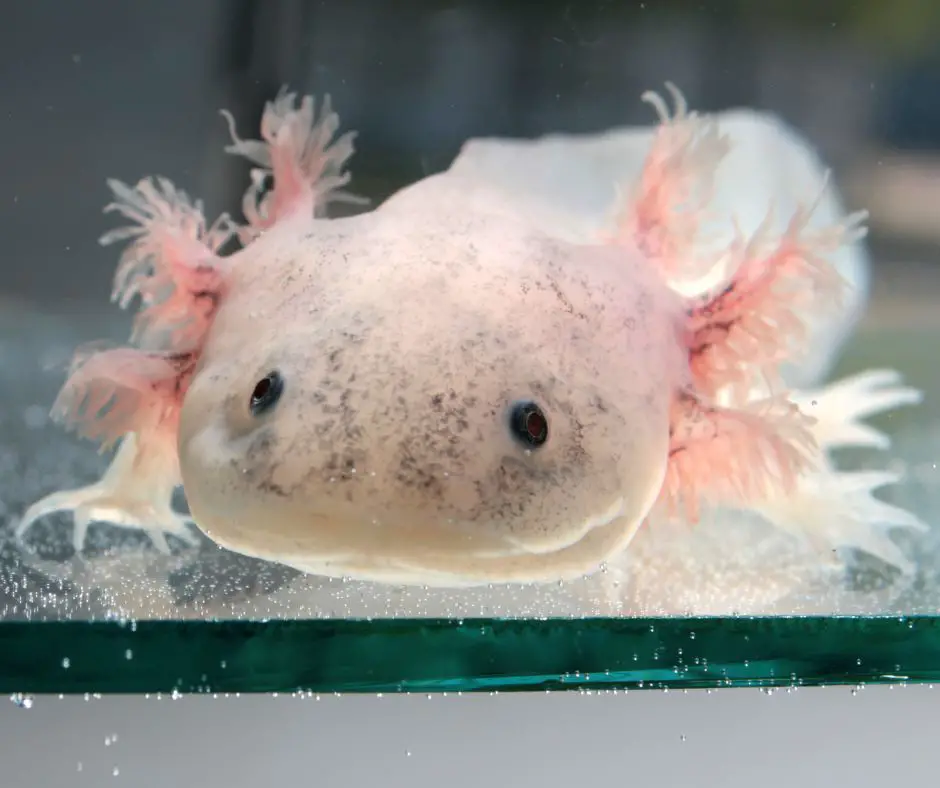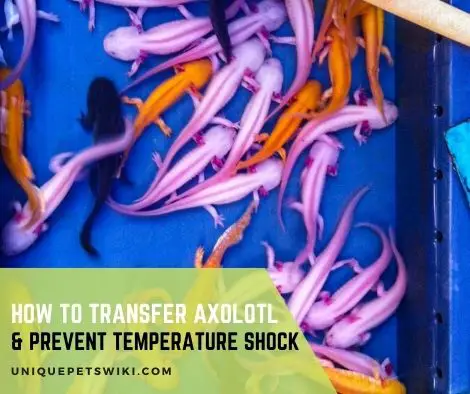If you own an axolotl, then you probably know that these cute and delicate creatures need a lot of TLC. They especially need specific conditions to thrive.
Axolotls are poikilotherms – this means they cannot regulate their body temperatures and are extremely sensitive to temperature changes. To prevent temperature shocks in axolotls you need to transfer them with a lot of care.
In this guide, we give you three methods of transferring axolotls to prevent temperature shock and heatstroke in axolotls.
Contents
How To Transfer Axolotl and Prevent Temperature Shock
There are 3 ways to transfer an axolotl but the method you select will depend on the circumstances you’re transferring in, the skill and experience level of the owner, the age of the axolotl, and also its temperament.
For example, a baby axolotl can be transferred from a tank to a container by net but a larger and friendlier axolotl can be transferred by hand or container.

Using a net
Axolotls are slippery creatures, even more so when they are juveniles. They swim very fast and are difficult to catch by hand.
That’s why transferring a baby axolotl is best done using a net. You can use this method when you’re transferring your baby axolotl from its main tank to a temporary tank/new tank.
You must not forget that axolotls are very delicate. They should not be dropped as their delicate cartilage could get damaged.
Steps to transfer an axolotl with a net
- Dip the net in the tank
- Gently catch your axolotl in the net. Place your hand over the net to prevent your pet from jumping out.
- Do not dump the axolotl in its new tank/container. Instead, dip the net in the tank and submerge it completely. Gently encourage your axolotl to swim out.
- Make the transition quickly; you do not want your axolotl to remain outside water for long.
Pros and Cons
- This method is safe for transferring baby axolotls or juveniles.
- On the downside, it can be dangerous as there is a chance that the axolotl could jump out of the net and injure itself.
PENN-PLAX Quick-Net Aquarium Fish Nets
- ESSENTIAL TOOL FOR FISHKEEPING: It’s always good to have an extra fish net for your aquarium! In addition to cleaning up some extra fish food that was accidentally poured, it becomes a handy tool when you need to quickly handle fish, and transfer them between tanks. They’re safe to use with both freshwater and saltwater fish, and come in various sizes!
- DURABLE, STRONG, AND SAFE: Each fish net features a vinyl covered, two-part braided handle that provides for an ergonomic grip, ensuring reliable operation with its strong design. Our aquarium fish nets won’t bend or become distorted over time, even with repetitive use. The mesh netting is appropriate for almost any type of aquarium fish, both freshwater and saltwater.
- MEASUREMENTS: The QN4 model of our Quick-Net line features a 4” x 3” net, with a handle length of 10”
- COLOR MAY VARY: Please be advised that our fish nets come in various shades of blue and green. We will ship based on availability. But rest assured, your fish won’t mind the difference in color, as long as they’re safely transported.
- SHOP PENN-PLAX FOR ALL YOUR PET’S NEEDS: PENN-PLAX is a manufacturer and distributor of top quality pet supplies, who specialize in creating excellent pet products for animals, both great and small.
Last update on 2022-12-29 / Affiliate links / Images from Amazon Product Advertising API
Using a Container
You can also use a container to safely transfer an axolotl to another tank or take it by car for a short distance. This method is the best way to transfer-friendly adult axolotls.
Steps to transfer an axolotl with a container
- Make sure the container is larger than the axolotl.
- Gently dip the container in the tank.
- Encourage your pet to swim into it.
- Once your axolotl is in, raise the container outside the tank and place a lid with a hole on it.
- You can now take your pet to the other tank or transport it in a car.
Pros and Cons
- This is a good method for safely transporting larger/adult axolotls.
- The downside is that the container will not have adequate oxygen. So, use it only for a short time – never more than a few hours as oxygen levels will deplete and ammonia will increase.
Rubbermaid Commercial Products Plastic Round
- QUALITY ENGINEERING - Its commercial grade, break-resistant, polypropylene material allows for greater durability, product visibility, and a smooth surface, allowing for easy cleaning.
- DESIGNED FOR AIR CIRCULATION - Round containers promote increased air circulation around the container and allow for quicker cooling times.
- TEMPERATURE RANGE - Made of FDA compliant materials, this food storage container is dishwasher safe and able to withstand temperatures from 35 to 150 degrees Fahrenheit.
- IDEAL FOR FOOD PREP - These containers come in a wide variaty of measured sizes, allowing perfect portion control for any diet or meal
- PERFECT SIZE FOR - Single serving meal prepping, small fruit and vegitables like Stawberries, Cherries, Kiwis, Asperagus, Lentils, Mushrooms, Green Beans
Last update on 2022-12-30 / Affiliate links / Images from Amazon Product Advertising API
By Hand
This method of transferring an axolotl is only recommended if you have the know-how. Axolotls are delicate creatures and they are also rather slippery. If they fall on the ground, they could get seriously injured.
They also absorb germs from your hands through their skin, so handling should be minimal.
Steps to transfer an axolotl by hand
- Wash your hands thoroughly with soap before touching your axolotl. Rinse them completely – take care there is no soapy residue.
- Handle your axolotl very gently. Use both hands to lift the axolotl out of its tank.
- Place your hands under its belly. To prevent your pet from wriggling or jumping, keep a firm-but-gentle grip right behind its front legs and in the front of its back legs. Its tail should hang between your wrists and its head should face your fingers.
- If your pet shows signs of panic or appears to want to swim away from your hands, let it do so. Do not force it. Try again once it is calmer.
Pros and cons
- This method of transferring your axolotl is only for experienced handlers.
- It is the best way to transfer an axolotl to another tank/container when you do not have a net.
- The downside is the danger of injury and germ contamination from your hands through their skin.
How to Prevent Temperature Shock in Axolotls During Transport
Axolotls are poikilotherms – this means they cannot regulate their body temperatures and are extremely sensitive to temperature changes. If you want to transfer your axolotl, you should carefully do it to prevent shocking their system.
There can be different scenarios where you’d need to transfer an axolotl. Based on the scenario, you can follow different steps as given below:
Case 1: Transferring an Axolotl from its Tank to Another Place
To help acclimatize your axolotl safely to a new tank, make sure that the water parameters in both, the old and new tank, are the same.
- Use a thermometer to check the temperature and test the water parameters in the old tank.
- Do the same thing with the new axolotl tank or container. Make sure all parameters are the same. Ideally – the water temperature should be between 16-18 deg C (60-64 F).
- You can also bring some of the water into the tank and fill it into the new container.
- Then, use one of the 3 ways described above to transfer the axolotl.
API 5-in-1 Test Strips Freshwater and Saltwater Aquarium Test Strips
- Contains one (1) API 5-IN-1 TEST STRIPS Freshwater and Saltwater Aquarium Test Strips 25-Count Box
- Monitors levels of pH, nitrite, nitrate carbonate and general water hardness in freshwater and saltwater aquariums
- Dip test strips into aquarium water and check colors for fast and accurate results
- Helps prevent invisible water problems that can be harmful to fish and cause fish loss
- Use for weekly monitoring and when water or fish problems appear
Last update on 2022-12-30 / Affiliate links / Images from Amazon Product Advertising API
Case 2: Transfer Axolotl from Another Place to Tank
When you buy an axolotl from a breeder, chances are they ship your pet to you in a bag with some cycled tank water.
Axolotls cannot survive for more than 24 hours in the bag. After this period, the oxygen levels in the bag reduce drastically and ammonia levels rise dangerously due to the waste accumulating in the bag.
There are two different ways to transfer an axolotl to a cycled tank from the bag it was shipped. The method you select will depend on how long it has been in the bag.
Use the following method if your axolotl has only been in the bag for a few hours.
- Gently pour the water and your axolotl into a large bowl or container from the bag.
- Add a quarter cup of water from the cycled tank to the container every 5 minutes for 30 minutes.
- Using a net, gently remove your axolotl from the container and place it in the cycled aquarium after 30 minutes.
- Avoid pouring the water from the container into the new tank.
However, if your axolotl has been in the bag for over 24 hours, use the following steps to transfer it to the cycled aquarium. These are very important because you need to quickly acclimatize your pet to the cycled tank.
- Place the bag holding your axolotl into the cycled aquarium but do not open the bag.
- Wait for 15 to 30 minutes to allow the water temperature in the aquarium and bag to equalize.
- Use a net to remove the axolotl and place it into the new aquarium.
- Note: Avoid spilling any of the water from the bag into the new aquarium.
- Switch off any aquarium lights for 24 hours to help reduce stress while your axolotls settle into the new tank.
Remember: if your axolotl arrives very cold, its movements will be slow and non-existent. This does not indicate ill-health. Your pet will start behaving normally once it adjusts to the higher temperature.
Conclusion – How To Transfer Axolotl?
To transfer your axolotl, you can use a net, your hand, or a container to transfer an axolotl from one tank to another.
When transporting in the car, place your axolotl in a Tupperware container inside a styrofoam cooler packed with ice and prevent vibrations using some blankets.
If you have just been shipped an axolotl in a bag, you need to place the bag in the aquarium where it needs to be housed for 15-30 minutes before opening the bag.
We hope this guide helps you transfer your axolotl safely.



